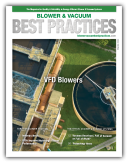By Antonio Mantilla, Product & Applications Marketing Manager, Atlas Copco
04/26/2021
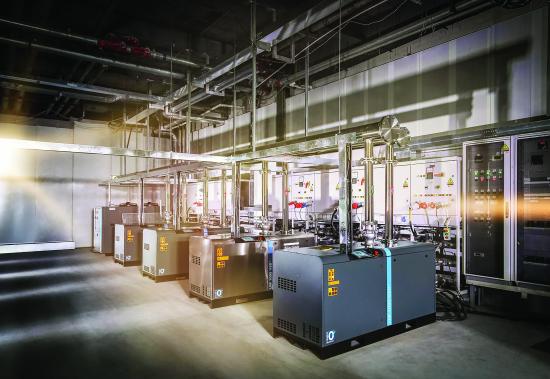
A centralized vacuum system with Atlas Copco LRP VSD+ Liquid Ring Pumps.
Many of us are familiar with sizing vacuum pumps based on throughput, process pressure requirements, chamber size, pump down times, conductance and leakage. In a lot of cases, humidity becomes an afterthought and unexpected things happen. Some of these unexpected things we learn to live with, like emulsified oil. In other cases, the unexpected things prevent the pump from performing the job it was intended for.
I have never been a fan of articles written by manufacturers in which whatever is lacked in content is made up by being a brand commercial. On the other hand, I’ve always liked “how to” articles that teach a new skillset, so…here we go.
Vapor Pressure
To understand what humidity does to a process, let’s begin with the concept of vapor pressure. As its name indicates, it’s the pressure of the vapor that is in the surface of a liquid at a specific temperature. The higher the temperature, the more energy the molecules have in that liquid, so the more eager they are to escape the boring land of liquids.
We are pretty used to water, so examples referencing it are often useful. Water at 86°F (30°C) has a vapor pressure of 30Torr. One atmosphere is 760Torr, so if we have 760Torr pressing on the surface of water at 86°F (30°C), the water molecules will not have enough energy to escape because 760Torr completely outweighs its futile 30Torr attempt for freedom. If we add heat to the water to invigorate the molecules and raise the temperature to 212°F (100°C), then the vapor pressure will be 760Torr. That is the same as the pressure holding them in place and, at that point, water starts to boil. Once we start generating a vacuum around the water, the internal energy required for the molecules to escape will be lower; if we pull a 30Torr vacuum over 86°F (30°C), the water will boil.
Let’s say I have a 1m^3 chamber containing 10 liters of water at 86°F (30°C). To make the math easy, let’s assume that the process is temperature compensated at 86°F (30°C) so that evaporation is not cooling my 10 liters of water, which will make the vapor pressure drop. If I were to pump down the chamber to 10Torr without the water in it with a 100m^3/hr pump, it will take roughly 2.5 minutes if we use the approximation:
S = V/t * ln (Pi/Pf)
S is the pump’s pumping speed, V is the volume of the chamber, t is time, Pi is the initial pressure and Pf is the final pressure. Now what happens when we put the 10 liters of water in the tank? Avogadro says that any 1 mol of ideal gas occupies 22.4Lts at normal conditions, and water is no exception. 1 mol of water weights 18 grams, so 10 liters (10,000grams) is equal to 555mol. At normal conditions, it would occupy 12,400Lts (12.4m^3). The problem is that water at 1 atmosphere and 32°F (0°C) is not a vapor, so we need to correct for pressure and temperature. That means:
12.4m^3 * (760Torr/30Torr) * (303K/273K) = 348m^3
Those innocent 10 liters of water will generate 348m^3 of water vapor at 30Torr and 86°F (30°C). Our 100m^3/hr pump will have to pump that so it will take a bit longer—approximately 3.48 hours more. What took 2.5 minutes before, now will take approximately 2 minutes to reach 30Torr, then the water will boil at that pressure and temperature for 3.48 hours, and then the pressure will go from 30 Torr to 10 in around 40 seconds. This is a very rough approximation because air will start carrying out water before it boils, and temperature compensated processes are not as common as one may think. If the target was to reach 10Torr in ten minutes, we may have undersized the pump quite a bit.
Some of you may be thinking, “But if my pump is not reaching the vapor pressure of water, I will not be boiling anything, and I have nothing to worry about.” While technically you are correct on the fact that you are not boiling the water, you may have a few things to worry about.
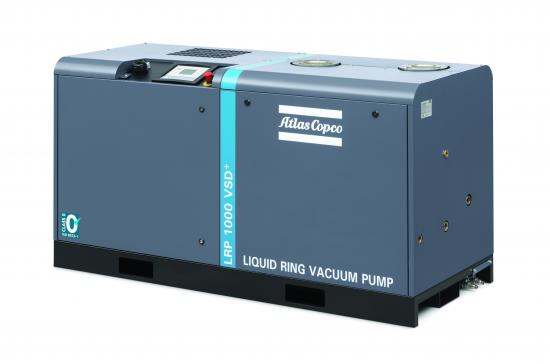
A liquid ring vacuum pump suited for humid, dirty and high temperature applications.
Saturation
To better understand what happens here, we invoke the concept of saturation. Air can carry a good amount of water. The ratio of water/air gets larger the hotter the air is, and the lower pressure is. This is the reason why when we spill a glass of water outside, we do not have to wait until the ambient temperature reaches 100C and boils the water for the puddle to dry up. This fortunately does not happen as it would make for a very uncomfortable day at the park. What really happens is that the dryer air around the puddle decides to soak itself in water and operate like a sponge. If the “sponge” is pretty dry, it can hold a lot more water that if it was partly soaked or saturated.
The amount of water that air can carry can be estimated by the following formula:
Mass flow of water = Mass flow of Air * (MW(water)/MW(air)) * (Pv(water)/(P-Pv(water)))
Mass flow of water and air are in any units, MW is in gr/mol and Pv is the vapor pressure of water which can be in any unit as well. The ratio of water to air will be adimensional. This means that if I have a process in which I am pumping 1kg/hr of saturated air @ 86°F (30°C) and 50Torr, that 1 kg/hr of air is carrying roughly another kg/hr of water. We are not boiling the water because its vapor pressure at 86°F (30°C) is 30Torr. This equals roughly to 35 m^3/hr.
So far this doesn’t seem to be a problem: we have a 35m^3/hr pump happily pumping 86°F (30°C) saturated air at 40Torr. What could go wrong?
The saturated air will enter the pump and must be compressed to atmospheric pressure to be exhausted. A reasonable exhaust temperature from an oil sealed vane pump will be around 158°F (70°C). At 760Torr and 158°F (70°C), the same 1kg/hr of air that was coming in can only carry 0.3kg/hr of water vapor. This means that the pump is able to pump water vapor in but not pump it out, so it eventually stays in the pump causing some problems. Water in oil will not lubricate very well, so the pump will suffer abnormal wear. Water inside of the pump will also evaporate, taking up some of its capacity so it will not pump as much and will not reach the pressures it used to.
So then, what can we do? There are a few options. The first question that needs to be answered is, “Does my process require me to boil the water?” In some cases it doesn’t, but we do it anyway. Some applications like degassing and water deoxygenation tend to take the process into the boiling point accidentally in detriment of the process itself. The idea is to remove oxygen from the water, or remove the bubbles from the shampoo, not to boil the product.
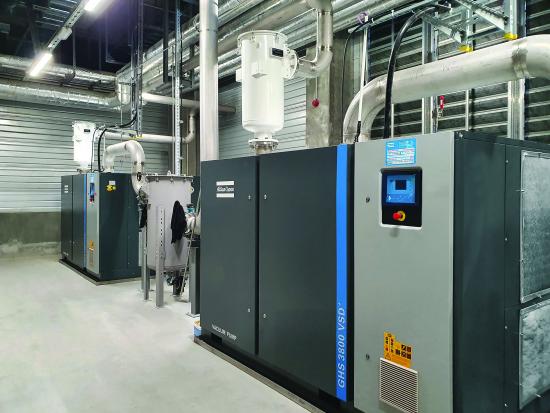
Installation of oil-sealed rotary screw vacuum pumps ideal for a range of applications in plastics, glass, bottling, canning, wood, packaging, printing and paper, meat packaging and many more.
Four Options to Consider
With that in mind, consider these four options.
1: Use a Liquid Ring Vacuum Pump
This has often been the traditional solution, and it works. A liquid ring vacuum pump is a vacuum pump, a water pump and a condenser, all in one. It is immune to water condensing inside because (in most cases) it is already being sealed with water, so a bit more water is not going to do any harm as long as the pump is able to move it and the amount is not large enough that it will heat up the ring to a point that induces cavitation at process pressures. There also needs to be enough non-condensable gas load to prevent cavitation. Pumping speed correction for vapor load is also an advantage because it will condense in the ring making the actual pumping speed of the unit larger than its nominal capacity. There are a few disadvantages that some companies can live with. Given that this is a vacuum pump plus a water pump and a condenser all in one, it consumes power and water like the sum of all three. Its operating pressure is restricted to the vapor pressure of the sealing liquid at the exhaust temperature, so they often can’t go lower than 25Torr with 59°F (15°C) cooling water before they start sounding like someone dropped marbles inside. The process may contaminate the seal water so sealant recovery may not be an option, and then water consumption and treating could add a few expenses.
2: Run a Hotter Pump
If the inside of the pump is close to 212°F (100°C), then there is the need for very little air to pump the water out in vapor phase. This is an option we offer on our lubricated screw line. A “humid” version can pump 100% water vapor given that it is programmed to operate with the gas ballast open, running controlled temperatures close to 212°F (100°C) and executing air purges in between cycles. That way the oil is always clean. Running a hot pump is also possible with other technologies, like dry claw, dry screw and vane, depending on the process pressure requirements and the budget.
3: Dilute
A gas ballast valve helps considerably but sometimes it is not enough. In some cases, purging with dry clean air and oversizing the pump to meet the process pressure with the higher gas load is an option. Going up to the next size pump and allowing air to leak into the inlet may maintain all the water in vapor phase. We can help calculate how much is needed and determine if this option is viable.
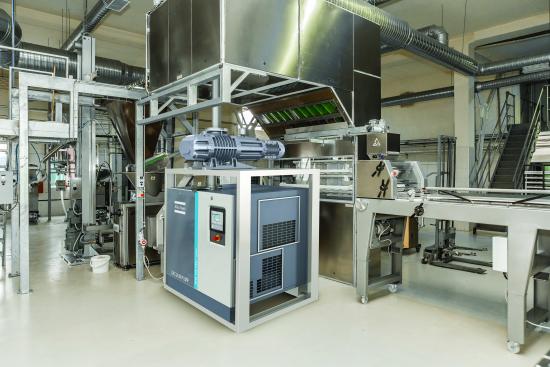
An Atlas Copco GHS VSD+ with a ZRS Mechanical Booster Pump. These booster pumps are suitable for use with high differential pressures which allow the booster pump to be started at the same time as the backing pump, reducing total pump down times.
4: Run at the Correct Pressure
If the process needs to run at 24” Hg, why run it at 25” Hg? Running at deeper vacuum is not always a bad thing, but every so often it is. The deeper you go unnecessarily, the higher the ratio of water/air, so you are more prone to condensing water in the pump. This is most critical when the process does not require you to boil the water in the first place. A VFD driven pump with a pressure setpoint is usually a great solution because it will not allow the pressure to be deeper than what is needed, and it will save energy in the meantime. This can be taken a step further with pump programming and a temperature sensor. There are versions of our lubricated screw pumps that measure the pressure and temperature at the inlet of the pump (or any other point in the process) and vary the setpoint pressure based on the vapor pressure curve of water. That way if it measures, for example, the temperature being 86°F (30°C) and the pressure being 30Torr, it will ramp down to not touch the boiling point and unnecessarily dry up the product.
Options like these are available as an off-the-shelf standard product. There are many considerations to take into account when selecting a pump, we hope this guide helps. Please don’t hesitate to contact us with any questions.
For more information contact Antonio Mantilla, Products & Applications, Atlas Copco, email: Antonio.mantilla@atlascopco.com, https://www.atlascopco.com/vacuum.
To read similar Industrial Vacuum Technology articles visit https://www.blowervacuumbestpractices.com/technology/rough-vac.

